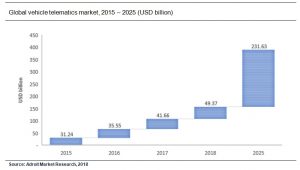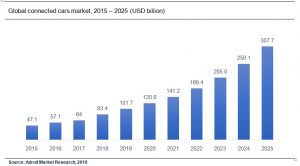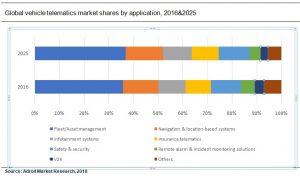Vehicle Telematics Advanced by 5G Technology, the Next Window of Opportunity in Connected Cars Market
Telematics, more colloquially identified as connectivity within a vehicle, has emerged as a popular field of modern communication. It is not only used in passenger cars but is being increasingly installed in existing fleet as well as off-road vehicles. There are numerous benefits of telematics, especially for businesses that depend heavily on automobiles, including safety & security, vehicle running & idle time, GPS, driver logs and diagnostics. Information of this nature is used to understand various aspects including telehealth, regular maintenance and availing appropriate insurance in case of accidents. A telematics unit typically collects all the necessary data of the vehicle and shares it with the user as well as OEM’s and insurance companies.
As the telematics market has tremendous future prospects due to various factors including government norms and regulations, every field and function of this particular technology is anticipated to grow significantly with a scope for advancement in each of these pockets. Additionally, the emergence of IoT a few years back and its commercialization in every field is likely to drive the growth of the telematics market as well. Concepts such as Internet of Everything (IoE), cellular vehicle-to-everything (C-V2X) and Vehicle-to-everything (V2X) are bound to roll off our tongues in the immediate future like tabs and fitbits are doing at present. The familiarization of such concepts is going to result in a higher consumer acceptance and thus, a great potential for innovation and growth for anyone who taps on this growth.
The global vehicle telematics market, limited only to passenger and commercial vehicles, was valued at USD 41.66 billion in 2017, a rise of more than 17% over the previous year. The figure below includes the estimated market changes between 2015 and 2025. The market is projected to grow at a CAGR of close to 25% from 2015 to 2025
Telematics as an industry is burgeoning with the revolution in communication technology and connectivity solutions. Inexpensive sensors, efficient data collection recording minute changes, data analytics and machine learning have enabled the telematics service providers to offer a wide array of services. These range from monitoring the vehicle and equipment to preparing for various contingencies beforehand and mobilize appropriate response for the situation.
Vehicle telematics has already gained a strong position in Europe and North America backed by strong support from regulations and consumer demand. The market scenario is pretty much on an autopilot in these regions driven by strong movement to develop better solutions for the industrial sector. The market players are focusing on generating competitive advantage by scaling up fast supported by cloud services and LTE based connectivity solutions. With autonomous vehicles making inroads to the market there is a higher need for the vehicles to be able to communicate with their surrounding environment.
Telematics is a step towards creating such an ecosystem and creating a network of such interacting entities within the system. Fleet management services has the highest potential for generating revenue in the next decade. The figure below demonstrates the estimate distribution of revenue from various applications of vehicle telematics globally.
Market players are working unceasingly to develop solutions based on AI and ML to enable seamless operations of an ecosystem and telematics is currently at the centre of this development. It is the structure that is intended to create and maintain harmony in the ecosystem.
Telematics is being adopted across all areas ranging from on-road passenger vehicles including two and four-wheelers to off-road heavy equipment used in construction and mining as well as in drones and marine equipment. Vehicle telematics is currently the star of the group and is set to maintain its position for a long time. GPS tracking and insurance services are the chief beneficiaries of vehicle telematics.
Connected cars are the major driver for vehicle telematics.
The connected cars market is anticipated to rise from USD 47.1 billion in 2015 to USD 307.7 billion in 2025. The market is driven by collaboration between technology developers and automotive OEM’s.
5G technology is finally at beta mode in the market and numerous pilots are being undertaken by the market leaders or players aspiring to gain a leadership position. The efficient 5G bandwidth allows for a seamless real-time communication with the vehicle. Some of the major initiatives and collaborations undertaken are listed below.
1. LG and Intel in Feb 2016, for developing and test 5G-based telematics technology and gain the first-mover advantage in LTE based telematics solutions
2. In February 2016, DENSO Corporation and NTT DOCOMO, INC. made an agreement to jointly research and develop vehicle control systems that utilize LTE and 5G, to realize advanced-driver-assistance and automated-driving-systems
3. In December 2016, LG, Ford, Verizon, Denso and Gemalto joined the 5G Automotive Association(5GAA)
4. LG and Qualcomm Technologies Inc., in Feb 2017, for tests and adoption of 5G and Cellular-V2X (C-V2X) communications into vehicles
5. In February 2017, Ficosa,joined the 5G Automotive Association (5GAA)
6. In March 2017, Samsung Electronics acquired Harman, a leading solution provider for the connected cars platform
7. In May 2017, Samsung Electronics was elected into a board membership of the 5G Automotive Association (5GAA) general meeting on May 11th. 5GAA’s mission is to speed-up the commercialization of communication solutions that advance mobility and safety on transportation networks.
8. In May 2017, Laird joined the Munich-based 5G Automotive Association (5GAA)
9. Continental and NTT DOCOMO Inc., in May 2017, collaborated to develop enhanced connected infotainment functionality and to build aplatform for cellular-based vehicle-to-everything (C-V2X) wireless communication systems
10. In November 2017, Intel, Ericsson, Toyota, Denso, and NTT DoCoMo declared achievement of speeds of 1Gbps and 600Mbps up while streaming 4K videos from a connected vehicle on a 5G trial network in Japan.
11. In Jan 2018, HARMAN and Samsung demonstrated high-speed connectivity in a futuristic mobility-concept-vehicle powered by the Samsung Networks 5G infrastructure, at CES 2018.HARMAN and Samsung are jointly working on development of modular approaches for advanced vehicle telematics, capable of 1 Gb/s bandwidth.
12. In Jan 2018, Continental, Ericsson, Nissan, NTT DOCOMO, INC., OKI and Qualcomm Technologies, Inc., declared plans to carry out their first Cellular-Vehicle-to-Everything (C-V2X) trials in Japan
13. In January 2018, Telefónica presented its 5G Technological Cities project, which hopes topave the way for 5G in Spain. The project will be tested with the initial deployment of 5G infrastructure in Segovia and Talavera de la Reina, in a partnership with Nokia and Ericsson. The initiative comprises the task performed together with SEAT and FICOSA on connected car applications. Such applications link vehicles to the road infrastructure and citizens andenhance safety and traffic management.
14. In January 2018, Bosch, Vodafone, and Huawei conducted a successful field-test using 5G cellular-V2X in a real-time situation
15. In February 2018, Telefónica and Huawei demonstrated the usage of 5G in self-driving-vehicles in a field trial in Spain
16. In March 2018, Huawei declared that it was the first company to complete a 5G NSA (Non-Stand Alone) functional test based on 3GPP. The NSA test was a part of the third-phase of China’s 5G technology tests in Beijing’s Huairou District. It was organized by the IMT-2020 (5G) Promotion Group, which aims to meet the ITU’s International Mobile Telecommunication system target date of 2020.
These initiatives are a testament that the global vehicle telematics market will see the launch of 5G enabled devices in the market in or before 2020. The telecommunication providers are bullishly investing in the development of 5G infrastructure in collaboration with OEM providers and are collectively supported by smart cities projects across the world. Connected cars are a part of the goal, i.e., a smart ecosystem of automated entities harmoniously operating and performing their own functions with higher efficiencies. Vehicle telematics is the solution that can enable connected cars and is projected to grow by leaps and bounds until the goal is achieved.
Author:
Sharmishtha Jatar, Research Analyst at Orbis Research





